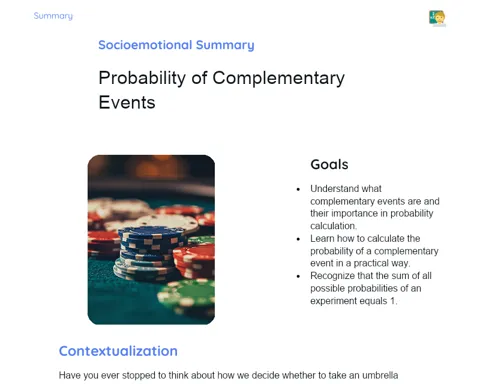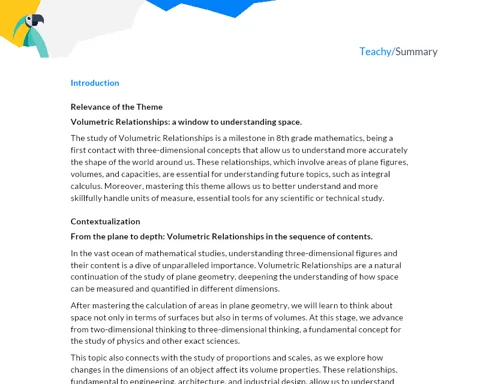TOPICS - Geometric Algorithms
Keywords
- Algorithm
- Geometry
- Cartesian Plane
- Coordinates
- Displacement
- Construction
- Folding
- Geometric Figures
- Reference Point
- Symmetry
Key Questions
- What is a geometric algorithm?
- How is a Cartesian plane used in geometric algorithms?
- In what way are coordinates important in object displacement?
- What are the basic steps to create a geometric fold?
- How to identify reference points for displacements in the plane?
Crucial Topics
- Sequential structuring of steps to solve geometric problems.
- Recognition and use of the Cartesian plane to locate points.
- Identification and application of symmetries in geometric constructions.
- Development of the ability to follow instructions in performing folds.
Specifics
Meanings
- Algorithm: Sequence of instructions to perform a task or solve a problem.
- Cartesian Plane: Coordinate system that allows locating points through ordered pairs (x, y).
- Displacement: Movement of an object from one point to another in space.
- Folding: Technique of creating shapes and structures by folding paper without cutting it.
- Reference Point: Specific location used as a base to describe the position of other points.
Vocabulary (Mathematics/Geometry)
- X and Y Axis: Perpendicular lines that form the Cartesian plane and help determine the position of points.
- Coordinates (x, y): Pairs of numbers that indicate the exact position of a point on the Cartesian plane.
Formulas
- Specific formulas are not applied for geometric algorithms in this context, but an understanding of measurements (distance, area, volume) and basic geometric relationships (such as theorems of congruence and similarity of triangles) are fundamental for advanced geometric constructions.
NOTES - Geometric Algorithms
-
Geometric Algorithm
- Finite and well-defined sequence of procedures or instructions to solve geometry problems.
- Originates from the earliest systematic methods of geometric construction and calculation, such as those of Euclid.
-
Cartesian Plane
- Created by René Descartes, it allows graphically representing ordered pairs of numbers.
- Important for visualizing points, lines, and geometric figures.
-
Coordinates
- Each point on the Cartesian plane is defined by a pair (x, y), which locates its exact position.
- Essential in geometric algorithms to define precise movements and constructions.
-
Displacement
- Change in the position of an object in space, which can be described by a vector in the Cartesian plane.
- Displacements help understand geometric transformations like translations.
-
Folding
- Art of transforming paper into various shapes (Origami).
- Folds follow a logical sequence of steps, often representing construction algorithms.
-
Geometric Figures
- Shapes that can be drawn on the Cartesian plane using points, lines, and curves.
- Knowledge of basic geometric figures is vital for geometric algorithms.
-
Reference Point
- Specific position that serves as a base to describe other points or to make measurements.
- In geometry, reference points are used to draw lines and shapes with precision.
-
Symmetry
- Property of a figure being identical on two or more parts, divided by an axis or plane.
- In geometric algorithms, symmetry simplifies the construction and analysis of shapes.
Examples and Cases
-
Locating Points on the Cartesian Plane
- To determine the location of a point P, we identify its coordinates (x, y).
- Example: P(3, 2) is 3 units to the right and 2 units above the origin (0, 0).
-
Building a Square Through Folding
- Start with a square sheet of paper.
- Fold the paper in half, from corner to corner, to find the center.
- Fold each corner to the center, thus forming a smaller square.
- Each step is a fold algorithm.
-
Describing the Displacement of an Object
- To move an object from point A to point B, we describe the displacement vector.
- If A is at (3, 5) and B is at (7, 10), the displacement is 4 units to the right and 5 units up.
These examples illustrate the concepts of geometric algorithms and their application in basic operations, composition of figures, and object movement on the Cartesian plane. Understanding these examples is essential to mastering the topic of geometric algorithms.
SUMMARY - Geometric Algorithms
- Geometric algorithms are sequences of steps to build figures or perform movements on the plane.
- The Cartesian plane is essential to locate points and visualize figures and displacements.
- Coordinates (x, y) determine the exact position of a point and are the basis for describing displacements.
- Folds are practical examples of geometric algorithms, combining art with mathematical precision.
- Geometric figures, such as squares and triangles, are built following specific algorithms.
- Reference points are used to ensure precision in construction and movement within the Cartesian plane.
- Symmetry facilitates the understanding of figures and the execution of geometric constructions.
Conclusions
- Geometric algorithms structure logical thinking and the approach to solving spatial problems.
- The ability to use the Cartesian plane is essential to successfully apply these algorithms.
- Understanding and applying coordinates is crucial to navigate and manipulate shapes in space.
- The practice of folding helps in the development of fine motor skills and in understanding sequential processes.
- Recognizing symmetries and reference points optimizes the study and practice of geometry.
- Practical examples illustrate the applicability of concepts and the importance of mastering geometric algorithms in everyday life.



